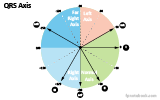II. Definitions
- Extreme Right Axis Deviation (right superior axis, -90 to 180)
- Negative net QRS voltage in lead I
- Negative net QRS voltage in lead avF
- On clock face, represents the 9:00 to 12:00 position
- Right Axis Deviation
- Deviation into lead III axis (+90 to -90 degrees)
- Negative net QRS voltage in lead I
- Positive net QRS voltage in lead avF
- On clock face, represents the 6:00 to 9:00 position
III. Interpretation: Based on most isoelectric lead
- Images
- Approach
- Extreme Right Axis Deviation (-90 to -180, negative in lead I and negative in lead avF)
- Most Isoelectric I (avF is perpendicular): -90 (12:00)
- Most Isoelectric avL (II is perpendicular): -120 (11:00)
- Most Isoelectric III (avR is perpendicular): -150 (10:00)
- Most Isoelectric avF (I is perpendicular): -180 (9:00)
- Right Axis Deviation (+180 to +90, negative in lead I and positive in lead avF)
- Most Isoelectric avF (I is perpendicular): +180 (9:00)
- Most Isoelectric II (avL is perpendicular): +150 (8:00)
- Most Isoelectric avR (III is perpendicular): +120 (7:00)
- Most Isoelectric I (avF is perpendicular): +90 (6:00)
IV. Causes
- Normal variation
- Chronic Obstructive Pulmonary Disease (COPD)
- Acute Pulmonary Embolism
- Right Ventricular Hypertrophy
- Right Bundle Branch Block
- Left Posterior Fascicular Block (Left Posterior Hemiblock)
- Dextrocardia
- Left ventricular ectopic rhythm
- Wolf-Parkinson-White Syndrome (WPW Syndrome)
- Prior lateral Myocardial Infarction
- Hyperkalemia
- Misplaced Limb Leads
- Sodium-channel Blocker (Class I Antiarrhythmic) Overdose
V. References
- Mattu (2020) Crit Dec Emerg Med 34(4): 18

